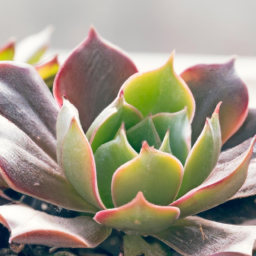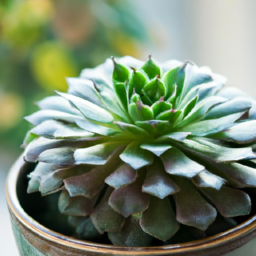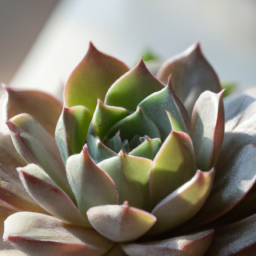
Are you looking to add some greenery to your indoor space? Indoor succulents are a great option for adding some life and color to your home or office. In this blog post, we will explore the names of indoor succulents that are perfect for bringing a touch of nature indoors. Whether you’re a seasoned plant parent or a beginner looking to start your indoor garden, there’s a succulent out there for everyone. So, let’s dive in and discover some of the most popular and unique names of indoor succulents that you can add to your collection.
Types of Indoor Succulents: A Guide to Popular Varieties
Welcome to our guide on the various types of indoor succulents! Succulents are a popular choice for indoor plants due to their unique shapes, sizes, and colors. In this article, we will explore some of the most popular varieties of indoor succulents that you can add to your home.
Echeveria
Echeveria is a genus of succulent plants that are known for their rosette-shaped leaves and vibrant colors. These plants come in a variety of shapes and sizes, making them a versatile choice for indoor gardens. Echeverias are easy to care for and can thrive in a variety of conditions, making them a popular choice for beginner gardeners.
Some popular varieties of Echeveria include Echeveria ‘Lola’, which features pink and purple leaves, and Echeveria ‘Perle von Nurnberg’, which has grayish-purple leaves with pink edges. These plants are perfect for adding a pop of color to your indoor space.
To care for Echeverias, make sure to provide them with plenty of sunlight and well-draining soil. Water them sparingly, as overwatering can cause root rot. With proper care, Echeverias can thrive indoors for years to come.
Sansevieria
Sansevieria, also known as snake plant or mother-in-law’s tongue, is a popular indoor succulent known for its tall, sword-shaped leaves. These plants are low-maintenance and can thrive in low light conditions, making them a perfect choice for beginners or those with limited sunlight in their homes.
Some popular varieties of Sansevieria include Sansevieria trifasciata, which has dark green leaves with light green horizontal stripes, and Sansevieria cylindrica, which features cylindrical leaves that grow in a fan shape. These plants are not only beautiful but also known for their air-purifying properties.
To care for Sansevierias, place them in indirect sunlight and water them sparingly. These plants are drought-tolerant and can go weeks without water, making them a great choice for busy plant owners. With minimal care, Sansevierias can thrive indoors and help purify the air in your home.
Crassula
Crassula is a genus of succulent plants that are known for their unique shapes and colors. These plants come in a variety of sizes, from small rosettes to tall, tree-like structures. Crassulas are easy to care for and can thrive in a variety of conditions, making them a popular choice for indoor gardens.
Some popular varieties of Crassula include Crassula ovata, also known as jade plant, which features thick, oval-shaped leaves, and Crassula perforata, which has stacked, triangular leaves that resemble a pagoda. These plants are perfect for adding a touch of whimsy to your indoor space.
To care for Crassulas, provide them with bright, indirect sunlight and well-draining soil. Water them sparingly, as overwatering can cause root rot. With proper care, Crassulas can thrive indoors and bring a unique charm to your home.

Best Indoor Succulents for Low Light Environments
Introduction
When it comes to choosing indoor succulents for low light environments, it’s important to select varieties that can thrive in less than ideal conditions. While most succulents prefer bright, indirect light, there are some species that are more tolerant of low light levels. In this guide, we’ll explore some of the best indoor succulents for low light environments and provide tips on how to care for them.
Snake Plant
Snake plants, also known as Sansevieria, are a popular choice for low light environments due to their ability to thrive in a wide range of conditions. These hardy succulents have long, sword-shaped leaves that come in a variety of colors and patterns. Snake plants are known for their air-purifying properties, making them a great choice for indoor spaces.
To care for a snake plant in a low light environment, place it in a spot where it will receive indirect sunlight for a few hours each day. Water sparingly, allowing the soil to dry out completely between waterings. Snake plants are drought-tolerant and can survive long periods without water, making them ideal for forgetful gardeners.
Propagation is easy with snake plants – simply divide the rhizomes or leaf cuttings and plant them in well-draining soil. With proper care, snake plants can thrive in low light environments and add a touch of greenery to any room.
ZZ Plant
The ZZ plant, or Zamioculcas zamiifolia, is another excellent choice for low light environments. This hardy succulent has glossy, dark green leaves that can tolerate low light conditions and neglect. ZZ plants are known for their ability to thrive in offices and other indoor spaces with minimal natural light.
To care for a ZZ plant in a low light environment, place it in a spot where it will receive indirect sunlight or artificial light. Water sparingly, allowing the soil to dry out between waterings. ZZ plants are drought-tolerant and can go weeks without water, making them a low-maintenance option for busy plant owners.
Propagation is simple with ZZ plants – just divide the rhizomes or leaf cuttings and plant them in well-draining soil. With minimal care, ZZ plants can thrive in low light environments and bring a touch of nature indoors.
Ponytail Palm
The ponytail palm, or Beaucarnea recurvata, is a unique succulent that can thrive in low light environments. This plant has a swollen trunk that stores water, allowing it to survive long periods without water. Ponytail palms have long, slender leaves that resemble a ponytail, giving them their name.
To care for a ponytail palm in a low light environment, place it in a spot where it will receive indirect sunlight for a few hours each day. Water sparingly, allowing the soil to dry out between waterings. Ponytail palms are drought-tolerant and can go weeks without water, making them a low-maintenance option for indoor spaces.
Propagation is possible with ponytail palms – simply remove offsets or pups from the base of the plant and plant them in well-draining soil. With proper care, ponytail palms can thrive in low light environments and add a touch of whimsy to any room.
In conclusion, there are several indoor succulents that can thrive in low light environments. Snake plants, ZZ plants, and ponytail palms are all excellent choices for indoor spaces with minimal natural light. With proper care and attention, these hardy succulents can thrive and bring a touch of greenery to any room.

Unique and Uncommon Names for Indoor Succulents
Indoor succulents are a popular choice for adding a touch of greenery to your home or office. With their unique shapes and colors, succulents can brighten up any space and provide a sense of tranquility. If you’re looking for something a little different, consider adding some unique and uncommon succulents to your collection. Here are some names of indoor succulents that are sure to stand out:
1. String of Pearls
String of Pearls is a unique succulent that features long, trailing stems lined with small, round leaves that resemble tiny pearls. This succulent is perfect for hanging baskets or trailing over the edge of a shelf. String of Pearls is easy to care for and can thrive in bright, indirect light.
When caring for String of Pearls, be sure to water sparingly, as overwatering can cause the stems to rot. Allow the soil to dry out completely between waterings, and make sure the plant has good drainage to prevent waterlogged roots. String of Pearls can also benefit from a light misting of water every now and then to increase humidity.
In terms of propagation, String of Pearls can be easily propagated by taking stem cuttings and allowing them to dry out before planting them in well-draining soil. With proper care, String of Pearls can grow into a lush, cascading plant that will add a unique touch to your indoor space.
2. Panda Plant
Panda Plant is a quirky succulent with soft, fuzzy leaves that are covered in tiny white hairs, giving them a silvery appearance. This succulent gets its name from the black spots that adorn the edges of its leaves, resembling a panda’s markings. Panda Plant is a low-maintenance succulent that thrives in bright, indirect light.
When caring for Panda Plant, be sure to water sparingly, as overwatering can cause the roots to rot. Allow the soil to dry out completely between waterings, and make sure the plant has good drainage to prevent waterlogged roots. Panda Plant can also benefit from occasional pruning to maintain its compact shape.
In terms of propagation, Panda Plant can be propagated by taking stem cuttings and allowing them to dry out before planting them in well-draining soil. With proper care, Panda Plant can grow into a bushy, compact plant that will add a playful touch to your indoor space.
3. Zebra Plant
Zebra Plant is a striking succulent with thick, dark green leaves that are adorned with white stripes, resembling a zebra’s markings. This unique succulent is sure to make a statement in any indoor space. Zebra Plant thrives in bright, indirect light and prefers to be watered sparingly.
When caring for Zebra Plant, be sure to water sparingly, as overwatering can cause the roots to rot. Allow the soil to dry out completely between waterings, and make sure the plant has good drainage to prevent waterlogged roots. Zebra Plant can also benefit from occasional misting to increase humidity.
In terms of propagation, Zebra Plant can be propagated by taking leaf cuttings and allowing them to dry out before planting them in well-draining soil. With proper care, Zebra Plant can grow into a stunning, eye-catching plant that will add a touch of drama to your indoor space.
Key Takeaways of this article
So you’ve decided to add some indoor succulents to your home, but now you’re faced with the dilemma of choosing the perfect ones. With so many different varieties to choose from, it can be overwhelming to know where to start. That’s why I’ve put together a list of some popular indoor succulents and their names to help you make the best decision for your space.
One of the most common indoor succulents is the Aloe Vera plant, known for its soothing gel that can be used for a variety of skin ailments. Another popular choice is the Echeveria, with its rosette-shaped leaves in a variety of colors like green, purple, and blue. If you’re looking for something a bit more unique, consider the String of Pearls succulent, which features long strands of small, bead-like leaves that cascade down the sides of its container. No matter which indoor succulent you choose, each one brings a touch of nature and beauty to your home while requiring minimal maintenance.
Here are the top questions that we were asked:
Q1. What are some popular names of indoor succulents?
A1. Some popular names of indoor succulents include Echeveria, Haworthia, Aloe Vera, Jade Plant, and Snake Plant.
Q2. Which indoor succulents are easy to care for?
A2. Echeveria, Jade Plant, and Snake Plant are known for being easy to care for as they require minimal watering and can thrive in indoor environments.
Q3. Are there any flowering indoor succulents?
A3. Yes, some indoor succulents like Kalanchoe and Christmas Cactus are known for their beautiful flowers that bloom indoors.
Q4. Can indoor succulents be placed in low light conditions?
A4. While most indoor succulents prefer bright, indirect light, there are some varieties like Haworthia and Gasteria that can tolerate low light conditions.
Q5. How often should indoor succulents be watered?
A5. Indoor succulents should be watered sparingly, allowing the soil to dry out completely between waterings. Typically, once every 1-2 weeks is sufficient, but it may vary depending on the specific succulent variety and environmental conditions.
Dr. Olivia Green is a botanist with over two decades of experience in indoor plant cultivation. She holds a Ph.D. in Plant Biology and has dedicated her career to researching plant behavior in controlled environments. Dr. Green is passionate about helping plant enthusiasts master the art of indoor gardening through her extensive knowledge and practical insights.


